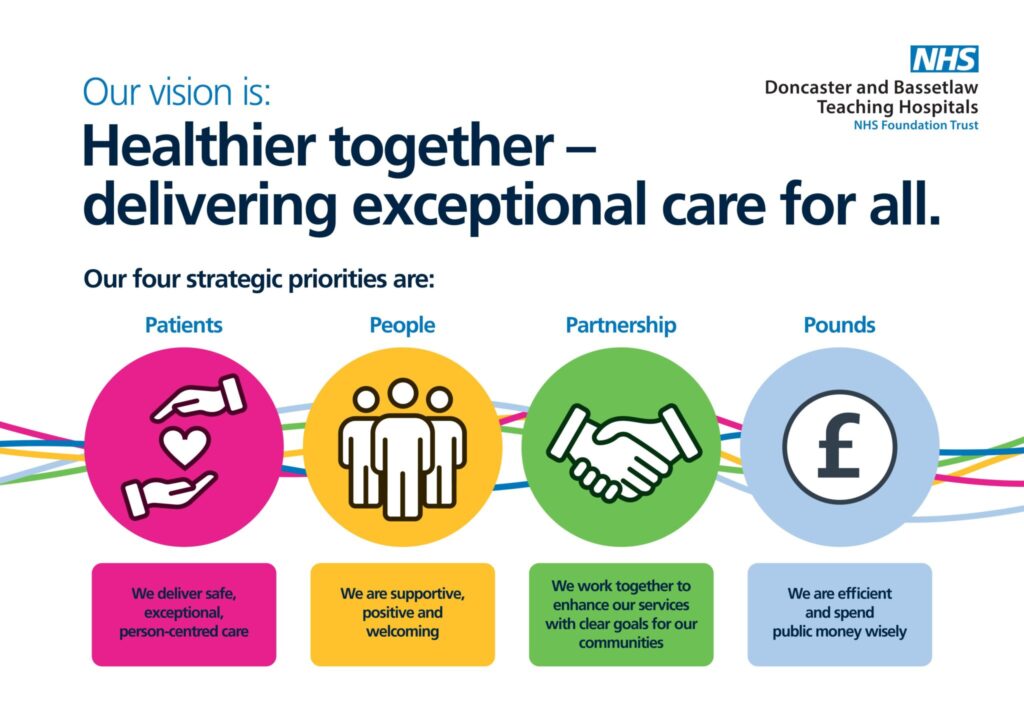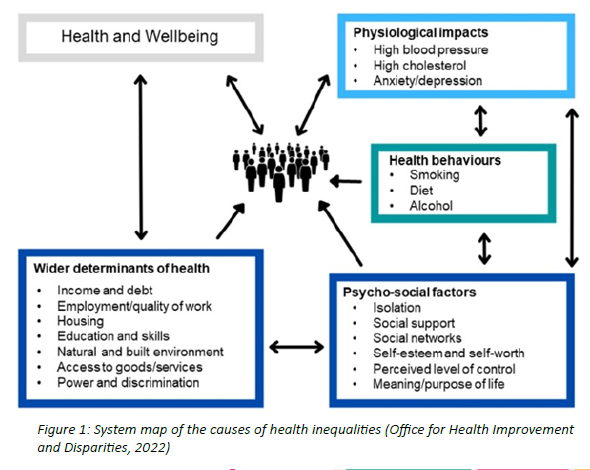There are a number of sections within this document. Using the links below, or to the side, you can skip to specific sections. Alternatively you can download this document as a PDF here.
- Foreword
- Executive Summary
- Three-tier framework
- Why do we need to tackle health inequalities?
- Health inequalities in Doncaster and Bassetlaw
- Our strategy
- Enablers to delivering the strategy
- The five pillars
- How are we going to deliver this strategy?
- Three tiers to support the strategy
- Training matrix
- Key performance indicators
- References and Appendices
If you need this page in another language, please head to: https://translate.google.co.uk. For more accessibility options and information, please visit: https://www.dbth.nhs.uk/a-z/accessibility/

The summary
If you’re short on time, you can listen to an audio summary of this strategy by clicking the media player below.
A note on our updated vision and strategic priorities
In April 2024, we refreshed our organisational vision. Our updated vision is:
Healthier together – delivering exceptional care for all.
To support this, we’ve introduced four new strategic priorities that underpin everything we do:
- Patients – We deliver safe, exceptional, person-centred care.
- People – We are supportive, positive, and welcoming.
- Partnership – We work together to enhance our services with clear goals for our communities.
- Pounds – We are efficient and spend public money wisely.
Please note: The enabling plan shown on this page remains relevant, but may refer to our previous vision and priorities. These have now been updated in line with our current direction.

Foreword
I am pleased to present Doncaster and Bassetlaw Teaching Hospitals’ (DBTH) first Health Inequalities Strategy, marking a significant step forward in our commitment to working to address the disparities in health outcomes within our communities. This strategy is a testament to our dedication to the principle that everyone deserves an equal opportunity to live a healthy life.
It is completely unreasonable that someone’s ethnic background or place of birth could be a determinant of their health. The urgency of DBTH’s mission to address this is clear within the statistics, which show over 40% of the Doncaster and 21% of the Bassetlaw populations live in some of the most deprived circumstances. Life expectancy for both males and females in these areas is lower than the national average, with many living for many years of their lives in ill health.
This strategy is our proactive response to these challenges, acknowledging the societal, economic, and health system costs associated with health inequalities. The strategy recognises the need for a fundamental shift in the way we operate, emphasising the importance of targeted support based on individual needs. By addressing systemic barriers and focusing on equitable access, we can make substantial strides in reducing health inequalities.
Aligned with national and local plans, to avoid duplication and to maximise collective resources, the strategy outlines key focus areas for the next five years, covering prevention, elective care pathways, urgent and emergency care, maternity and best start in life, children and young people, and research and innovation. It also focuses on enhancing awareness and understanding of health inequalities among our staff.
In line with the nature of the strategy, this is the first of our strategies developed to be fully accessible; meaning it can be put into digital software, such as a screen reader, or translation software, and be converted to be understandable format for a range of communities—something we are committed to do with all future strategies.
Thank you to everyone involved in shaping, reading and committing to the delivery of this strategy. It reflects our shared commitment to a healthier, fairer future for all of our communities.
Richard Parker
Chief Executive
Doncaster and Bassetlaw Teaching Hospitals

Executive summary
Health inequalities are “avoidable, unfair and systematic differences in health between different groups of people.” They mean that some population groups have significantly worse health experiences and outcomes than others. These differences can be due to a range of factors including a person’s social, economic and environmental circumstances – and we know that greater deprivation in any of these factors is associated with an increased risk of becoming ill earlier and dying younger. People with certain characteristics, such as certain ethnicities, sexual orientation, age, and disabilities, also have a lower chance of living a long and healthy life compared to others. This is often due to the exclusion from society that people with these characteristics face.
At Doncaster and Bassetlaw Teaching Hospitals Foundation Trust (DBTH) we want to do all we can to tackle unfair health inequalities so have developed this strategy with the aim to embed the reduction of health inequalities in everything we do to ensure equitable access and excellent experience, thereby providing optimal outcomes for our patients and the communities that we serve. In order to achieve this aim, our strategy has set out 6 priority areas of focus which include:
- Prevention
- Elective care pathways / recovery
- Urgent and emergency care pathways
- Maternity and best start in life
- Children and young people
- Research and innovation
The 6 priority areas are underpinned by 1 base and 5 pillars. The base provides the foundation to the delivery of this strategy and refers to enhancing our communications, awareness and education of health inequalities for our people, our patients and our local communities. The 5 pillars encompass behaviours, models of practice and a general ethos/culture shift which when implemented will support all the work across all 6 priority areas.
These pillars include:
- Understanding our communities – to ensure accurate, complete and timely access to population health data in conjunction with community voices to better understand the health inequalities and where to focus our action.
- Connecting people – to work closely with partners and build on existing relationships, networks, and trust. This will ensure work is aligned and supported and will prevent silo-working allowing health inequalities to be addressed using a whole system approach.
- Model of delivery – to move towards a more needs-led, compassionate social model of care and to use co-production to improve existing services and/or develop new services based on the needs of our communities.
- Access to and experience of services – to focus on the Core20PLUS5, ensuring targeted support is provided for the Core20 and PLUS groups, including inclusion health groups, particularly (but not exclusively) across the 5 service areas for adults and children and young people.
- Leadership and accountability – strong leadership and clear accountability and governance structures will support a culture shift and help to embed health inequalities in everything we do, acknowledging that our staff may also be experiencing health inequalities.

DBTH’s three-tier framework for improving health and tackling health inequalities
(Adapted with permission from Barnsley’s Integrated Care Partnership framework)
Tier 1 – Increase Support: The first layer of action is to increase engagement, opportunities, services and support to address the key drivers of health inequalities for people in need and making every contact count.
To ensure people have access to support that prevents them getting sick and reduces the drivers of inequality in their life, we need our teams (both clinical and non-clinical) across the Trust to be discussing health inequalities, to highlight where gaps in knowledge may be and/or to identify potential areas for improvement.
Tier 2 – Improve Care: The second layer of action is to improve all health and care services in such a way that they are targeted to greatest need and reduce inequalities in care.
To ensure that DBTH does all that it can to provide care and support to those with the greatest need first, teams/services should consider reframing the phrase “hard to reach groups” to instead answer the question “why are our services often hardest to access for the people who need them most?”
Tier 3 – Influence Others: The third layer is to influence those differences in health which are linked to things like housing conditions, the quality of green spaces and clean air, education and income, i.e. the wider determinants of health, by becoming the best anchor institution we can be and advocating for health equity across all sectors.
To ensure that due consideration is given to the impact that the Trust has on health and wellbeing by means other than the services it delivers, which can lead to huge impacts and far-reaching benefits.
Key Terms
(Office for Health Improvement and Disparities, 2021)
- Health Inequalities: Avoidable differences in health outcomes between groups or populations – such as differences in how long we live, or the age at which we get preventable diseases or health conditions.
- Equity: We want fair outcomes for everyone. What is important is addressing avoidable or remediable differences in health between groups of people. To achieve health equity, some groups may need more or different support or resources to achieve the same outcomes. Ideally, the barriers to good health would be removed for everyone, so adjustments wouldn’t be required – however, this is not always possible.
- Equality: We want everyone to have equally good health. However, the term ‘equality’ is sometimes used to describe equal treatment or access for everyone regardless of need or outcome.
- Access: Ensuring everyone can access services equitably (that is according to need) is a key priority for the NHS. To achieve this, consideration needs to be given to access to information, services and support. Central to this is enabling people to access the right service at the right time for them, reducing variation in the avoidable use of urgent support such as accident and emergency services through better access to preventative care.

What are Health Inequalities?
Health inequalities are “avoidable, unfair and systematic differences in health between different groups of people” (The King’s Fund, 2022). They mean that some population groups have significantly worse health experiences and outcomes than others.
These differences can be due to a range of factors including a person’s social, economic and environmental circumstances – and we know that greater deprivation in any of these factors is associated with an increased risk of becoming ill earlier and dying younger. People with certain characteristics, such as certain ethnicities, sexual orientation, age and disabilities, also have a lower chance of living a long and healthy life compared to others. This is often due to exclusion from society.
Comparing life expectancy in Doncaster and Bassetlaw between the most and least deprived communities:
-
In Doncaster:
- Men living in the most deprived areas die on average 10 years earlier than those in the least deprived areas.
- For women, the difference is 8 years.
-
In Bassetlaw:
- Men living in the most deprived areas die on average almost 8 years earlier than those in the least deprived areas.
- For women, the difference is 6 years.
A wide range of factors influence our ability to be healthy. These often overlap and are outside the control of individuals.
System map of the causes of health inequalities
(Adapted from Office for Health Improvement and Disparities, 2022)
Health and wellbeing
Physiological impacts
- High blood pressure
- High cholesterol
- Anxiety / depression
Health behaviours
- Smoking
- Diet
- Alcohol
Psycho-social factors
- Isolation
- Social support
- Social networks
- Self-esteem and self-worth
- Perceived level of control
- Meaning / purpose of life
Wider determinants of health
- Income and debt
- Employability / quality of work
- Housing
- Education and skills
- Natural and built environment
- Access to goods / services
- Power and discrimination

Why do we need to tackle Health Inequalities?
Addressing health inequalities is a matter of social justice – some have less health than others, largely due to structural factors, not individual choices. It is unfair that just by virtue of someone’s ethnic background or place of birth they should experience poorer health.
These avoidable differences also pose a huge cost to societal, economic and health systems. As cost-effective approaches to maintain health shrink, demand for expensive treatment services grows.
Examples:
-
The economic burden of preventable and premature illness is around £31 billion per year in lost productivity, and £20–32 billion per year in lost tax revenue and benefit payments (PHE, 2021).
-
NHS secondary care costs are 22% higher for women and 16% higher for men living in the most deprived areas.
Thus, health is a major determinant of economic performance. Tackling health inequalities:
-
Improves lives
-
Reduces NHS/social care costs
-
Benefits the economy
Equality vs Equity – why equity matters
Much of the way national and local systems have been set up has inadvertently contributed to increasing health inequalities. Therefore, we need to do things differently.
A key visual explanation used in the strategy (Figure 2) outlines the difference:
-
Equality: Everyone gets the same support – but this assumes everyone can access services equally.
(Like giving everyone the same-sized box to see over a fence, even if they’re different heights.)
-
Equity: Everyone gets the support they need – recognising different barriers and providing targeted support to overcome them.
(Giving shorter people more boxes so they can see over the fence too.)
-
Justice: The systemic barrier is removed entirely – everyone can access services equally, without needing additional support.
(The fence is replaced with a clear view – no boxes needed.)
While national policies are key to systemic change, local action can make a significant difference. This strategy sets out DBTH’s commitment to reducing inequalities with practical, tailored approaches.

Health inequalities in Doncaster and Bassetlaw
Table 1 below presents a few key figures which demonstrate the extent of some of the health inequalities facing people from Doncaster and Bassetlaw. To summarise:
- Over 40% of the Doncaster population and 21% of the Bassetlaw population are living in the 2 most deprived Index of Multiple Deprivation (IMD) deciles nationally, i.e. the “Core 20”.
- In Doncaster, almost a quarter of our children are living in low-income families, and in Bassetlaw it’s almost a fifth.
- In terms of life expectancy for males and females, both Doncaster and Bassetlaw are lower than the national average.
- The difference in life expectancy from the most to the least deprived areas in Doncaster is almost 10 years for males and 8 years for females. For Bassetlaw, the differences in life expectancy from the most to least deprived is almost 8 years for males and 6 years for females. Just to put that into context – a man from the most deprived area of Doncaster is living on average 11 years less than a man from the least deprived area. Similarly, a man living in the most deprived area of Bassetlaw is living on average 9 years less than a man from the least deprived area.
- Healthy life expectancy for males and females in both Doncaster and Bassetlaw is lower than the England average and if we just pull out the data here for females in Doncaster, we can see that the amount of time females are living in good health (i.e. their healthy life expectancy) is 56 years, but their average life expectancy is 81 years. This means that they are living for on average 25 years in poor health and during that time, will likely be accessing a range of health services.
| Indicator | Doncaster | Bassetlaw |
|---|---|---|
| % living in most deprived IMD decile (1) | 25.0% | 8.0% |
| % living in IMD deciles 1 & 2 (Core20) | 41.3% | 21.4% |
| % children in low-income families | 22.6% | 16.0% |
| Life expectancy – males | 77.8 years | 78.9 years |
| Life expectancy – females | 81.0 years | 82.0 years |
| Life expectancy gap – males | 10.0 years | 7.6 years |
| Life expectancy gap – females | 8.2 years | 5.8 years |
| Healthy life expectancy – males | 57.4 years | 62.0 years |
| Healthy life expectancy – females | 56.1 years | 61.9 years |
Key takeaway: Women in Doncaster live an average of 25 years in poor health – a major concern for healthcare use, quality of life, and resources.

Our Strategy
The Tackling Health Inequalities Strategy 2023–2028 has been developed in alignment with local and national strategies, ensuring collaboration, resource sharing, and system-wide effectiveness. Key strategies considered include:
- The NHS Long Term Plan – commits to improving prevention and tackling inequalities.
- NHS England’s “Actionable Insights” – improving access, experience, and outcomes.
- Core20PLUS5 – a national framework to address healthcare inequalities.
- South Yorkshire and Nottingham & Nottinghamshire ICB Joint Forward Plans
- Doncaster 1 Plan 2023/24
- Bassetlaw Place Plan
Core20PLUS5 Framework – Adults
-
Core20: The most deprived 20% of the national population (based on IMD deciles 1 and 2).
In Doncaster, 41% of the population fall into this group.
-
PLUS: Additional population groups not captured in Core20 who experience poorer health outcomes. These include:
-
People with protected characteristics
-
Those in deprived geographies (urban, rural, coastal)
-
Inclusion health groups (e.g. people experiencing homelessness, Gypsy/Roma/Traveller communities, offenders, sex workers)
-
-
Five clinical focus areas (adults):
-
Maternity services
-
Severe mental illness
-
Chronic respiratory disease
-
Early cancer diagnosis
-
Hypertension case-finding
-
Smoking cessation is identified as a theme relevant to all five areas.

Core20PLUS5 Framework – Children and Young People
The same Core20 and PLUS concepts apply, but the five clinical priorities differ:
- Asthma
- Diabetes
- Epilepsy
- Oral health
- Mental health

For full details on the frameworks, DBTH references:
We have also reviewed some of our own strategies and plans, and feel that our Tackling Health Inequalities Strategy has clear links with a number of key organisational strategies at DBTH:
Quality Improvement and Innovation (Qii) Strategy 2023–2028
The Qii Strategy directly references our Tackling Health Inequalities Strategy, identifying synergies—particularly within the co-production and leadership elements, which align with our five pillars (details to follow). Health inequalities training is being incorporated into Qii training to ensure these issues are considered in all improvement initiatives. We also plan to use Qii methodologies to support health inequalities-specific improvement projects.
DBTH Green Plan 2022
There are clear connections between the actions identified in the Green Plan and health inequalities. For example, decarbonisation reduces air pollution, which disproportionately affects people from lower socioeconomic backgrounds. Reducing emissions, therefore, contributes to reducing health inequalities. The Green Plan also promotes access to preventative health advice, supporting improved health outcomes and reducing demand on services—ultimately lowering the Trust’s carbon footprint. Both sustainability and health inequalities work contribute to the Anchor Institution agenda and support DBTH in being a “good” Anchor Institute.
People Strategy 2023–2027
Several elements of the People Strategy complement our Tackling Health Inequalities Strategy, particularly as many of our people are also our patients. Key links include:
- A focus on Just Culture
- Inclusion of health inequalities questions in SET training (with 90% compliance)
- Ongoing Equality, Diversity and Inclusion (EDI) work to embed a culture representative of the communities we serve
- Enhanced inclusive recruitment practices
- Delivery of health inequalities actions within the EDI Improvement Plan
- Workforce planning and development, including apprenticeships
- Anchor institution and widening participation efforts through access to education and employment
Nursing, Midwifery and Allied Health Professionals Quality Strategy 2023–2027
There are clear links to:
- Strategic Theme 2 – Patient Experience: embedding patient involvement and co-design in policies and holding community engagement events to reach seldom-heard groups and those impacted by inequalities
- Strategic Theme 3 – Clinical Effectiveness: using Qii methodology to address inequalities in care
- Strategic Theme 5 – Care of Our Most Vulnerable Patients: promoting equitable access to healthcare to reduce inequalities
Research and Innovation (R&I) Strategy 2023–2028
Tackling health inequalities is a cross-cutting theme throughout this strategy. The aim is to ensure all research and innovation at DBTH considers the impact on health inequalities from design through to adoption. A key strategic priority is improving outcomes through prevention, early diagnosis, and better management of cardiovascular and respiratory diseases, as well as cancer—supporting the Core20PLUS5 framework and wider prevention agenda.
Our strategy has been developed through engagement with DBTH colleagues and leaders, supporting our True North objectives and strategic aim to be:
“The safest Trust in England, outstanding in all we do.”
This is an ambitious strategy—designed to challenge, promote innovation, and drive meaningful action.
It will be supported by a detailed action plan, setting out how we will tackle health inequalities across six priority areas over the next five years.
Our six key priorities are:
- Prevention
- Elective care pathways
- Urgent and emergency care
- Maternity / best start in life
- Children and young people
- Research and innovation
Our ultimate aim is to embed the reduction of health inequalities in everything we do, ensuring equitable access, excellent experiences, and improved outcomes for all patients and the communities we serve.

There is a great deal of existing work already underway within many of these priority areas. The Health Inequalities Team intends to provide support, advice, and expertise to these ongoing programmes to ensure that tackling health inequalities is embedded within them. We can also support the development of targeted initiatives to reduce inequalities where appropriate.
Prevention
Primary prevention aims to reduce the incidence of disease by taking action before health issues arise. This includes universal measures (e.g. anti-smoking campaigns, smoke-free hospital messaging) and targeted interventions for high-risk groups (e.g. vaccinations).
Secondary prevention involves early detection and intervention before full symptoms develop—for example, managing blood pressure and cholesterol to prevent cardiovascular disease or screening for cervical cancer.
Tertiary prevention seeks to reduce the impact of ongoing health problems by improving quality of life and life expectancy—such as supporting patients with asthma to stop smoking.
Aligned with the Core20PLUS5 framework, our focus within the prevention priority area includes:
-
Smoking cessation – Supporting the QUIT Programme
-
Alcohol and substance misuse services
-
Cardiovascular disease – Emphasising hypertension case-finding and optimising blood pressure and lipid management
-
Chronic respiratory disease – Focusing on COPD, promoting uptake of COVID, flu and pneumonia vaccines to prevent exacerbations and emergency admissions
-
Early cancer diagnosis – Supporting the NHS England target of diagnosing 75% of cancers at stage 1 or 2 by 2028
-
Vaccinations – Exploring how we can support improved uptake of childhood vaccines (e.g. MMR) when patients present to our services
Prevention is also a key theme running throughout the other priority areas.
Elective care pathways and elective recovery
While meeting national elective recovery targets is essential, it is equally important to avoid further exacerbating existing health inequalities. A letter from Sir James Mackey, National Director of Elective Recovery (23 May 2023), outlined the expectation for systems to demonstrate how health inequality actions are being implemented and evidenced using disaggregated data.
To support this, we need:
-
Accurate and timely disaggregated data (at minimum: age, gender, ethnicity, Index of Multiple Deprivation score)
-
Health inequalities assessments embedded within recovery planning
-
Support from the Health Inequalities Team to ensure all pathways and interventions are developed through an equity lens
A key area of focus is the reduction of Did Not Attend (DNA) and Was Not Brought (WNB) rates, which currently exceed 9% each month across all services. Reducing these rates could improve patient experience, productivity, and waiting times.
To do this, we must understand the root causes—such as financial barriers to transport—and develop targeted responses, for example:
-
Arranging transport for specific patient groups
-
Analysing the role of digital exclusion, ensuring interventions (e.g. SMS/email reminders) don’t unintentionally widen inequalities
Some patients, such as those experiencing homelessness, may be more reliant on digital communication than paper correspondence—demonstrating the importance of tailoring interventions to need.
There is also an opportunity to link with the prevention priority through “waiting well” initiatives, targeting those at higher risk of deteriorating health while waiting for appointments or procedures.
It is essential that any changes to elective care pathways are developed collaboratively with primary care and Integrated Care Board (ICB) partners to avoid unintended consequences or duplication across the system.
Urgent and emergency care (UEC)
There is a clear two-way relationship between health inequalities and urgent and emergency care. For example, data from South Yorkshire and Bassetlaw between 2013/14 and 2017/18 shows that individuals from the most deprived areas are significantly more likely to require emergency admission.
To address this, the Health Inequalities Team will work with UEC colleagues to:
-
Analyse disaggregated data to identify need and target improvements
-
Embed interventions that consider inequalities across UEC pathways
Key areas of focus include:
-
Making Every Contact Count (MECC) – Embedding opportunities to address wider health and social needs during emergency presentations, such as:
-
Smoking cessation
-
Alcohol/substance misuse
-
Vaccination and screening
-
Housing and financial advice
-
Mental wellbeing support
This could involve signposting or even hosting services directly within emergency departments (e.g. Citizens Advice).
-
-
High intensity users – British Red Cross research has shown that:
-
Fewer than 1% of people account for over 16% of A&E attendances
-
These individuals are also responsible for 29% of ambulance journeys and 26% of admissions
-
Mortality rates for frequent users aged 30–50 are 7.5 times higher than the general population
-
The estimated cost to the NHS is £2.5 billion per year
-
To address this, we will:
-
Use ECIST (Emergency Care Improvement Support Team) data and other sources to better understand high intensity users locally
-
Develop targeted support and demand management initiatives
-
Ensure a tailored approach that considers the broader determinants of health and inequalities
Content out of date? Information wrong or not clear enough? Report this page.
